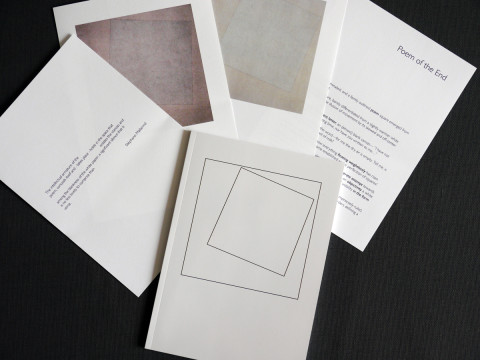
An Imperfect Mirror, 2013:
A ‘book’ of 15 loose pages in a clam-shell box; printed with offset lithography in silver ink, the cards mirror enough to reflect the light but not much else. The book combines original and found texts on art and reflection
The text includes:
FOR HER, VISION CONSISTED IN SURPRISING THE SYMBOL OF THE THING IN THE THING ITSELF
HER DRESS WAS IN HOPELESS BAD TASTE
ART IS AN IMPERFECT MIRROR
SHE FELT A CERTAIN REDUNDANCY
REFERENCING SOMETHING OUTSIDE THE FRAME
NOT x BUT ABOUT x
AT THE SIGHT OF THE MOST COMMONPLACE OBJECTS: A DOORKNOB, FOR EXAMPLE, OR A TRAM TRACK


Senzaporta, 2013:
“Fog, the accidents of exposure, the atmosphere of memory, this placement of figures into a landscape that absorbs them– In truth, any explanation would be less interesting than the mystery itself.”
 A series of found photographs seem to tell a story. As is written on the reverse, the year is 1960 – the year Antonioni’s Lâ Aventura was booed at Cannes – the place is somewhere in Italy. Knowing this, one cannot help but see similarities between the photos and the films: in the apartment blocks which are sprouting in the distance and also in the framing of the figure: always standing off to the side, diminished, almost absorbed by the space around her. The grainy-ness of the photos adds to the sense of atmosphere and isolation – an isolation both in space and time, which the figure’s diminutive size in relation to the composition also serves to underline. In the second half of the book an impressionistic text – a remix combining text sampled from Antonioni’s film sketches and that of other writers with those of the author – reflects on the photos while hinting at a larger narrative.
A series of found photographs seem to tell a story. As is written on the reverse, the year is 1960 – the year Antonioni’s Lâ Aventura was booed at Cannes – the place is somewhere in Italy. Knowing this, one cannot help but see similarities between the photos and the films: in the apartment blocks which are sprouting in the distance and also in the framing of the figure: always standing off to the side, diminished, almost absorbed by the space around her. The grainy-ness of the photos adds to the sense of atmosphere and isolation – an isolation both in space and time, which the figure’s diminutive size in relation to the composition also serves to underline. In the second half of the book an impressionistic text – a remix combining text sampled from Antonioni’s film sketches and that of other writers with those of the author – reflects on the photos while hinting at a larger narrative.
available at Printed Matter

10 White Lies and Poem of the End, 2015:
white lie (n.)
- an often trivial, diplomatic or well-intentioned untruth
- a minor or unimportant lie, especially one uttered in the interests of tact or politeness
10 images from various web sources present 10 dramatically different takes on the original. All are identified as Malevich’s White on White, but few succeed well in their interpretation. A selection from the accompanying text “Poem of the End” which draws on descriptions of the painting, Malevich’s own words and those of his contemporaries:
Color was eliminated, and a faintly outlined poem square emerged from its background.
A geometric figure, barely differentiated from a slightly warmer white ground – given the illusion of movement by its skewed and off-center position.
A blank page an unsent letter, an (almost) blank canvas – “I have not written to you for a long time, nor have you written to me.”
Thirsting, not even for the word – ”for me the dry air is empty. Tell me, is the milk bottle the symbol of milk?
See now a white square how everything floating weightlessly has risen up in a white field and become established as the perfection of squares!
…